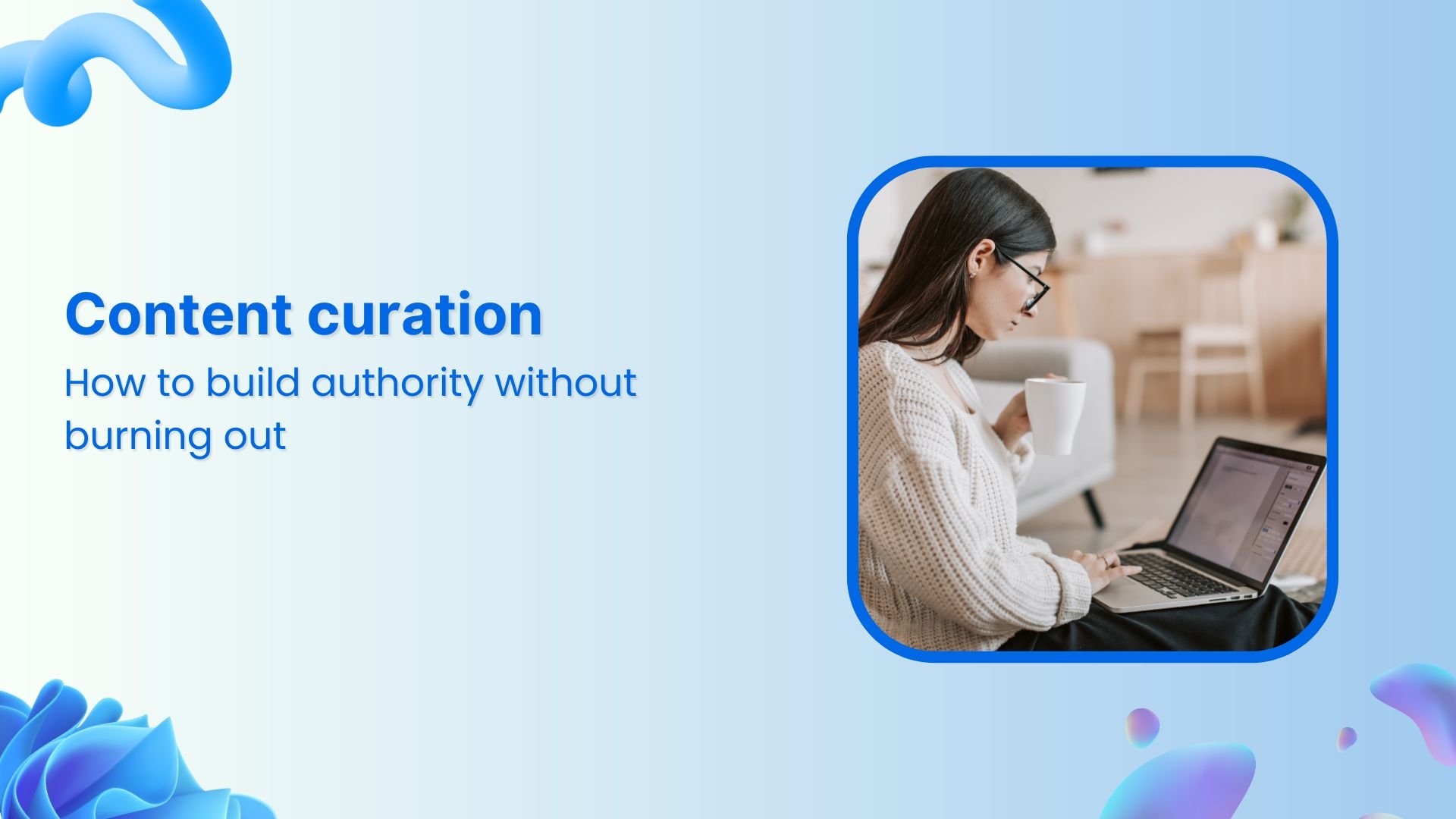Bulk-generate & schedule posts in seconds with Smart Scheduling. Try now!
LinkedIn Content Strategy: Building a Content Plan to Skyrocket LinkedIn Reach
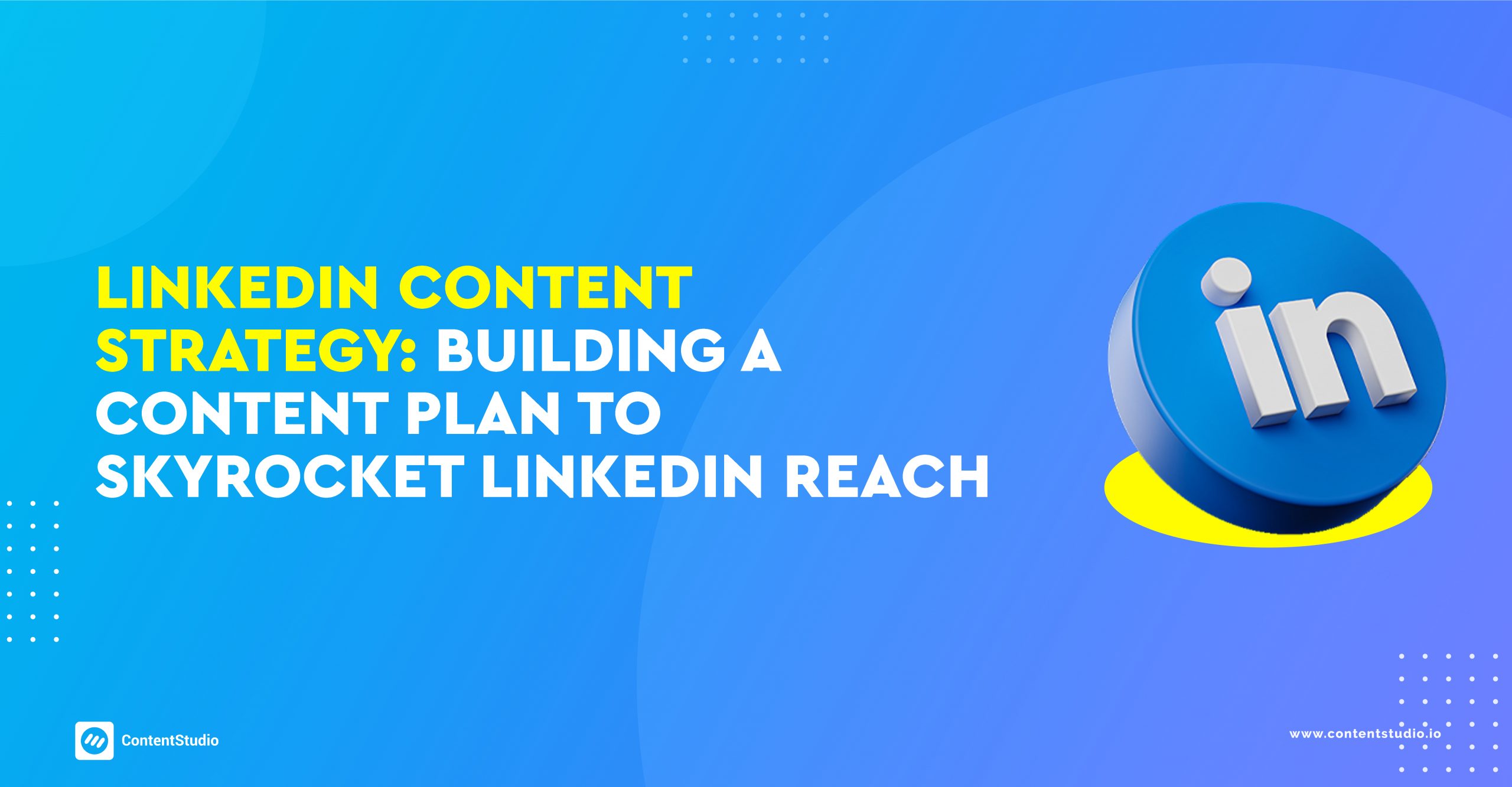
LinkedIn is perhaps the most underrated social media platform that provides you with everything that any major social media platform has to offer. Some companies and influencers are finally able to see LinkedIn as more than a recruitment platform. Whereas, the majority of us haven’t figured it out yet. Learn how you can use LinkedIn content Strategy to increase your LinkedIn reach.
We all have seen how Facebook’s organic reach went south, and now some of us are looking at Instagram to dominate, and others are finding new areas to tap on for attention. LinkedIn is one of those platforms that most of us haven’t capitalized on yet. I bet most of you have profiles on LinkedIn, but you don’t put out content or engage with people more often. I can tell that because I have been doing the same until a few months ago.
Let me tell you that organic reach on LinkedIn is way better than Facebook and Twitter. The content distribution facility on LinkedIn puts it among the top social media platforms for marketers, businesses, and influencers.
Gary Vaynerchuk often talks about the power of LinkedIn. He recently highlighted LinkedIn and TikTok as two very important social media platforms to pay attention to these days.
Moreover, he shared that he posts videos and images on LinkedIn as well. It seems that LinkedIn is the next social media platform that brands and experts would hop on for organic reach, conversion, and engagement.
However, the point is that if you want to amass attention on LinkedIn, you need to use the content as a pillar to establish your brand’s structure. Therefore, it leads us to build an actionable LinkedIn content plan to boost your LinkedIn reach, following, and engagement.
4 Key Elements to Skyrocketing Your LinkedIn Reach
- Self-awareness
It all starts with self-awareness: if you aren’t sure what you’re good at or what you want to pursue, you won’t get anywhere on LinkedIn. The reason is that it’s a social network of professionals; everyone on LinkedIn is a job-holder or an employer or a self-employed person. So you have to be sure of your capabilities and skills to build connections with the right people from your industry. If you are skeptical about your career, you might end up frustrated or keep switching your profile details to fit in. This is why self-awareness would bring in clarity, and it’s important to start on the right foot, too.
- Target Audience
To cash in on the LinkedIn platform, you must know who you’re going to reach out to and connect with on the platform. The target audience is the market segment that may need your advice or product or help. The idea isn’t to find customers but to develop relationships and build authority over time. Once you know your target audience, it’d help you create better content that would attract the audience to pay attention to you. You can use automation tools to streamline this process. Once your profile starts to get traction, you’d see fans converting into loyal customers. It would not have been possible without reaching out to the right audience. So you better understand who the heck is your audience.
- Community
Once you get started with building connections and sharing content on LinkedIn, you have to engage with the followers and people connected with you. It doesn’t mean you start sending them messages to check out your content or requesting them to leave a comment on your posts. It all begins with the basics: if someone likes your post, tag and thank them in the comment. Similarly, when someone mentions you, take some time out and read the post and respond to it positively.
Moreover, you can share others’ content on your LinkedIn profile to increase engagement and interaction on the platform. When you continue doing things like these, it’d start to build a community around your profile and brand, which would massively impact your LinkedIn reach.
- Value
Value means putting your time, energy, and sweat into helping others. If your content or views or voice is making a difference in your followers’ lives, it means you’re delivering value to them. The biggest secret of LinkedIn reach and engagement is providing value to others because it helps you stand out from the crowd. Infuse “value” as a major ingredient of your content plan on LinkedIn and see what happens afterward.
Now, you’ve known the basic principles of getting traction on LinkedIn.
Let’s take a look at five steps of building a LinkedIn content strategy to increase the reach on the platform:
5 Steps to build LinkedIn Content Strategy.
#1: Understand Your Brand Persona
You must indeed get off on the right foot to make things right. Otherwise, you’d realize at some point that you wasted your time and energy, and got nowhere so far.
Understanding your brand persona might seem like a no-brainer. Some of you might think: if someone is creating a LinkedIn profile, he or she would know about their brand persona. That’s where you’re wrong because not everyone out there understands this.
Brand persona means building a presence with a conscious mindset and approach. Your profile and appearance must resonate with your true version.
You must put in the effort into describing your brand persona — even if the contemplation takes a few days. You can’t make a mistake at the starting point because if the foundation is flawed, the building is likely to collapse at some point.
The upside of understanding your brand persona is more of a lightning rod. Here are some benefits of figuring out who you are and what you like:
- It influences your content strategy on LinkedIn
- It lets you connect with the relevant people
- You get to engage with the related community
- Your brand persona shapes the outcome of your online presence
- You’re able to reach out to the prospective audience
For example, take a look at Brigette Hyacinth‘s LinkedIn Profile:
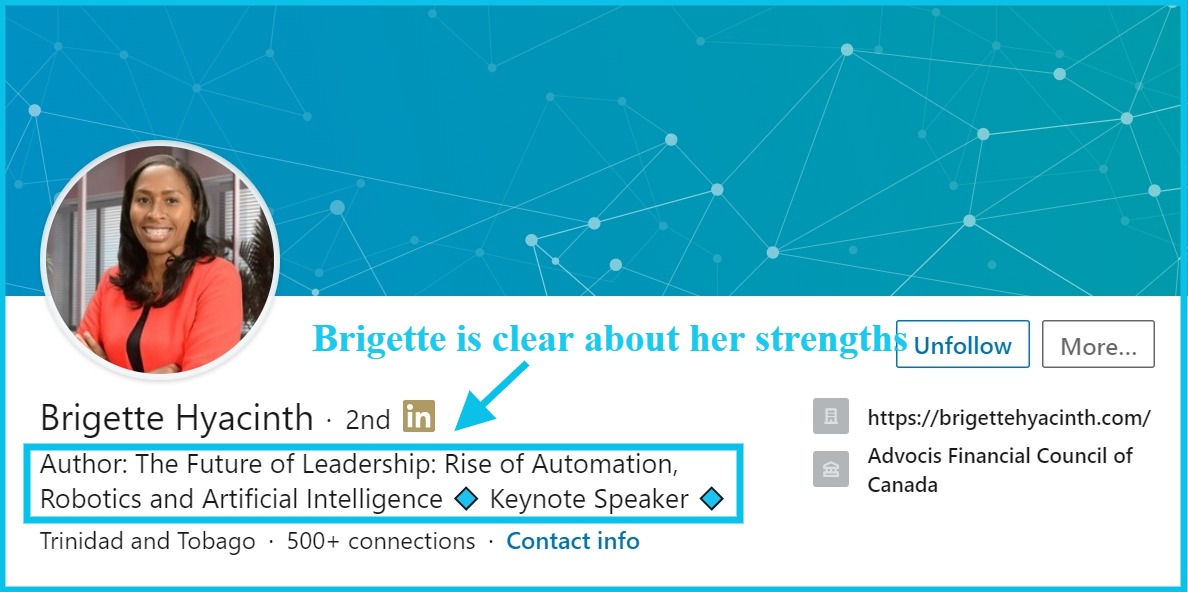
She has made it pretty clear on her profile that what she is interested in.
Not only did she mention “Robotics and Artificial Intelligence” as her industry, but she also highlighted her book which happens to be on automation. It does look that she is crystal clear about her brand persona.
Moreover, this example validates the idea that a brand persona is a vital ingredient in building a sustainable social media existence on LinkedIn.
Let’s take another example.
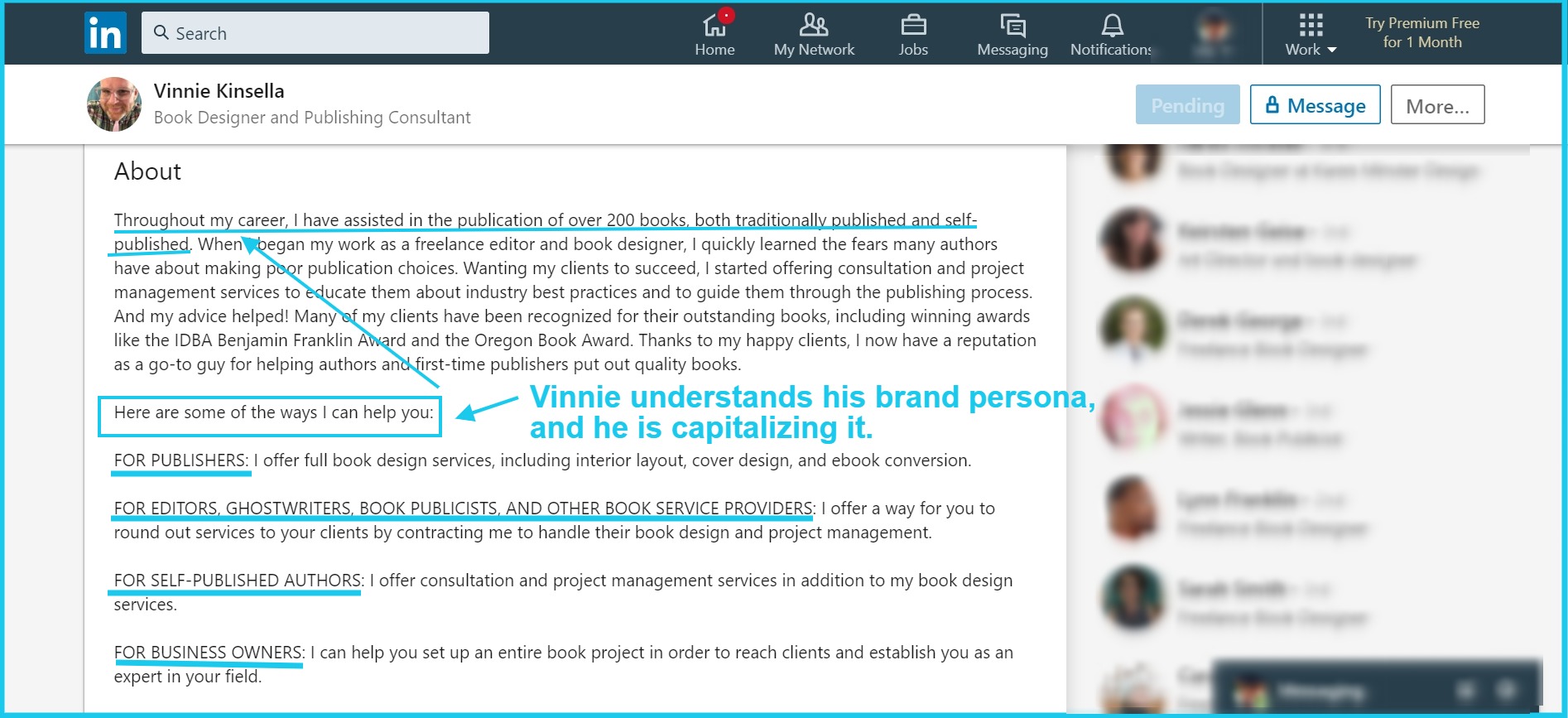
Meet Vinnie Kinsella:
Vinnie already knows what I’m talking about here. He has clarified everything about his business model in the About section of his LinkedIn profile.
How many profiles have you seen that have explained products or services like that?
The number might be very low.
What you can take away from step #1 is that you should be pretty clear of your strengths, skills, and services if you want to dominate on LinkedIn. When your goal is to maximize your LinkedIn reach, you should capitalize on every opportunity to get eyeballs on your brand.
And, the good news is that it all starts from understanding your brand persona, and now you know it.
#2: Shape Your LinkedIn Content Plan
One of the pillars of skyrocketing your reach on LinkedIn is the content you put out on LinkedIn. Most people you meet on social media might not be creating any type of content, but they won’t mind getting more followers.
The interesting thing about the large segment of the audience which doesn’t create content is that they consume content, somehow. So being a content creator on any social media platform puts you on a pedestal because the majority of people are consuming, not creating content.
In case, you haven’t thought about creating content on any social media platform, let me share some benefits of content creation. Content allows you to:
- Start a conversation
- Share an idea with a larger audience
- Solve others’ problems
- Provide an avenue for communication
- Connect with like-minded people through comments
When content seems to be an untapped source of attention, engagement, and traffic, then why everyone out there is not taking advantage of it.
There are two reasons for that:
- Awareness: People lack an understanding of social media. A lot of them would hang out on Facebook, share memes, leave sarcastic comments, and watch cat videos all day.
- Content Creation: Let’s admit that content creation isn’t easy — people deviate from putting in the work on social media because it’s tough. Ordinary content doesn’t work and quality content requires energy and sweat.
To develop a LinkedIn content plan, you need to figure out the following things:
Brand’s Strength
A brand’s strength means what makes your brand stand out from the crowd. If you’re a graphic design service firm, there might be many more out there. So what makes your company better than others?
- Does your website look appealing?
- Do you charge a lower price than the competition?
- Is your customer service the best of all?
Once you know your strength, you can cash in while creating relevant content on LinkedIn.
Gary Vaynerchuk is the best example of using a brand’s strength while creating LinkedIn content. Budding entrepreneurs and aspiring entrepreneurs around the world follow him for entrepreneurial guidelines and inspirational doze about using social media.

Gary knows his brand’s strength so he always delivers valuable, helpful, and educational content on business, mindset, and entrepreneurship on every social media platform including LinkedIn.
A content plan without having a taste of your brand’s strength would be meaningless to you as well as your audience. Imagine if the legendary golfer Tiger Woods would be asked for a piece of advice on horseback riding. What could he possibly know about horseback riding? That might be a waste of an opportunity.
So understanding your brand’s strength would pay off in LinkedIn content creation.
Prospective Audience
An essential part of building a LinkedIn content plan is the awareness of the prospective audience. If you sell sports bikes and you’re trying to put out content regarding private jets, it won’t work out for you no matter what you do.
Understand your prospective audience better so that it could reflect in your content on LinkedIn. When the right audience starts to encounter your content, it would brew engagement, which would lead to more following.
Mano Guiragossian is the founder of The Champs Marketing. It’s a digital marketing services company. He understands his prospective audience, which is why he is talking about the quality and quantity of content.
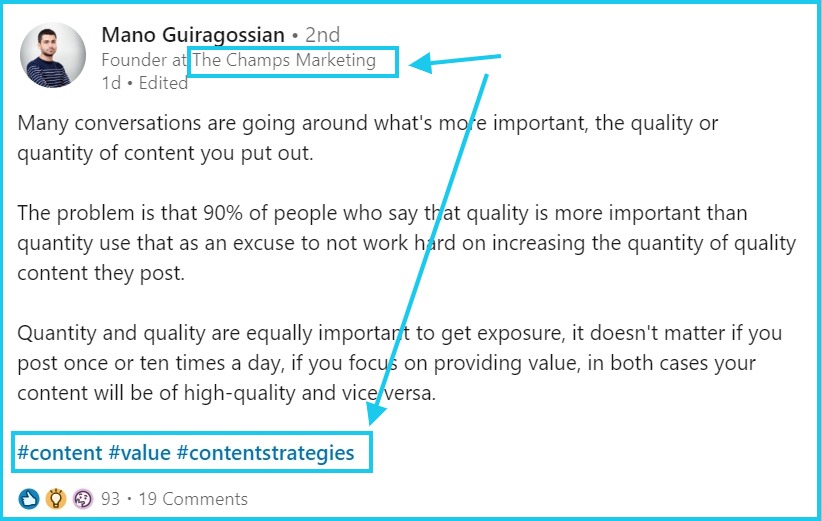
He knows what his prospective audience might be thinking or talking about at the moment. Not only did he come up with a good argument, but he also stood up for what he believes in.
The more you understand your prospective audience and market segments, the better your content plan would become.
Pain Points
Pain points are the weaknesses or challenges your audience faces. The entrepreneurs or brands that dominate social media are usually good at figuring out the pain points of their prospective audience. It’s also true that you must first identify your capability to solve someone else’s problem. Once you know your strength, it becomes evident that you can use your strength to solve others’ problems.
For example, Corey D. Rose runs an SEO agency called Search Geeks. The company provides SEO services to clients looking to grow organic website traffic.
Corey posted a video regarding Google Ads Campaigns in which he’s trying to solve a pain point of the audience:
When you figure out these things, you get to know what you’re going to talk about.
Some business owners don’t put out content because they don’t know where to begin in content marketing.
So shaping your LinkedIn content plan doesn’t have to be a pain.
The above-mentioned three indicators will help you build your LinkedIn content plan, even if you haven’t written blog posts or posted social media images on Facebook or Instagram.
Once you start on the right foot, you’d get one step closer to increasing your LinkedIn reach through the right type of content.
#3: Post on LinkedIn More Often
There is no shortcut to getting more reach on LinkedIn. You must put out more content, but it has to be done strategically.
Whenever someone says “you should post on social media more often,” it seems like a vague solution. Most of us ponder what exactly we should be posting more.
I don’t want to give the same, regular suggestion of posting more on LinkedIn, but instead, I’ll go one step further and talk about what and how to post more on LinkedIn.
There are three basic things you can do if you’re struggling to post content on LinkedIn:
1) Create Content in Bulk
It doesn’t matter whether you post a text-based status, a quote in image form, or an article — you have to come up with a system of creating LinkedIn content in bulk quantity. It’s virtually impossible to write a fresh status or design social media images every morning to post on LinkedIn.
When you sit down to create content in bulk, you’d end up creating more than one piece — repeat that process a few times, and you’ll have a bunch of pieces to publish on LinkedIn. Just make sure that you aren’t pivoting from your niche while creating LinkedIn content in bulk form.
2) Use a Social Media Scheduling Tool
A social media management tool is a must. You have to have a social media tool for scheduling your LinkedIn content. ContentStudio is one of the most popular social media management tools for bloggers, entrepreneurs, and businesses. Once your content is ready, go ahead and schedule your LinkedIn content through ContentStudio.
A social media scheduling tool is essential to this process because you might not be able to log in to your LinkedIn account to post content a few times a day. It’s a tried-and-test methodology: if you want to post more on social media, you got to have a social media marketing tool.
3) Analyze the Top-performing Content
Once your scheduled content starts to go live on LinkedIn via your social media management tool, the next thing you’d want to do is analyze the content performance. Look out for the posts that are getting more likes, comments, and shares. You might want to get into the conversations in the comments section to further elaborate your points or make your stance crystal clear.
As a result, you’d start to understand what your audience wants and how your chosen topics are helping them. This way, you’d be able to provide more tailored content to your audience.

Louise Myers says you should post at least twice a week on LinkedIn, but she also hinted about using a tool called Missinglettr that suggests content pieces to share on social media.
Every expert has their own point-of-view on the number of posts on each social platform.
Here’s another one:

We posted an article about LinkedIn publishing — according to the data, Tuesday, Wednesday, and Thursday are better performing days than Friday, Saturday, Sunday, and Monday.
Moreover, you can always test out your LinkedIn content publishing schedule and decide for yourself the best day and time to post on LinkedIn.
Remember that every top social media network has a flux of content coming through; if you want to dominate or at least get some attention, you have to put it out more often.
However, don’t let the “more often” syndrome paralyze you from doing what’s convenient for you or suitable for your audience.
The goal is to provide you with ideas and solutions to put out content with ease, not to pressure you to put everything behind and create content.
Related Read: Social Media Algorithms 2022: Updates & Tips by Platform
#4: Provide Value to Your Followers
One of the secrets to skyrocketing your LinkedIn reach is to provide unconditional value to your followers. We are taught a give-and-ask mentality in the marketing world. If you’re providing a freebie checklist in PDF form, you’re doing this because you want to build your email list. If you’re providing a 15-day free trial of your software, you want people to purchase it. I don’t say this is the wrong approach to winning clients, but it might not be the best way to win loyal followers.
One shouldn’t underrate the power of giving away unconditional value to the followers. I stumbled upon a LinkedIn post, and it validates my point of providing real value.
Kirsty Bonner took her time to write a compelling post on LinkedIn. She went on to explain the key points of succeeding on LinkedIn.
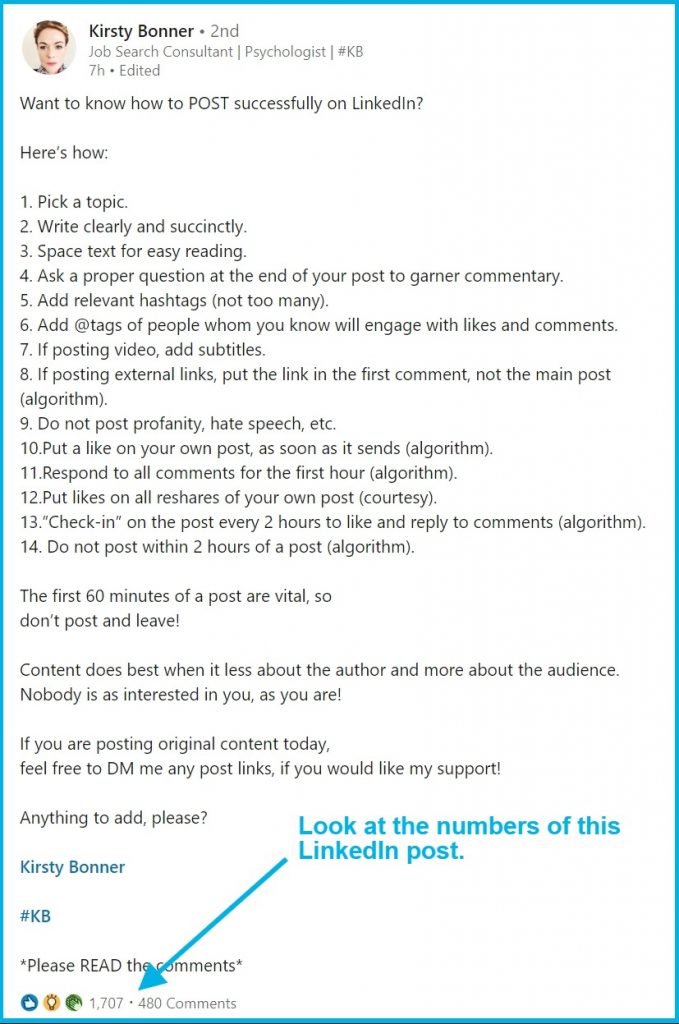
The steps Kirsty shared are spot on — no wonder her post got 1,700 reactions and 400+ comments.
If you deliver value without expectations, not only would fans stop by but others may also join the tribe. That’s the beauty of modern-day social media. When people start to pay attention to a certain piece of content, social networks start to boost the reach of that piece, and it works like a snowball effect.
Sarah Leblanc wrote a meaningful point in her LinkedIn article. She said, “It really doesn’t matter how often you post if your content isn’t valuable.”

She knows the impact of delivering value through content, which is why she doesn’t care how often do you post on social media.
The article caught my attention because a lot of people get frustrated by not being able to post more and others expect quick results after posting a few times a day.
I do not doubt that if you deliver value whether it’s an article, video, or text-based post on LinkedIn, people would start to notice you. It’s not possible that you provide invaluable teaching to the right audience and it goes in vain. Sure, every piece of content doesn’t get the same amount of attention, but some useful content pieces certainly turn things around.
There is a default psychological pattern we see on social media:
- People like a funny video, they share it
- Someone reads a joke, it’ll be shared
- Your friend stumbled upon a meme, you got tagged in the comments
- You watch an educational post, you re-share on your timeline
- A meaningful quotation shows up on the feed, people would share with friends
Laughter, happiness, and care are the reactions we show when we see any sort of value in the content. Then, we immediately feel obligated to share with family or friends.
Once you understand the key to creating that kind of valuable content, you’d start to see traction on social media, and eventually, your reach on LinkedIn would significantly improve over time.
#5: Develop a Strong Community
What if I tell you the biggest secret of increasing LinkedIn reach is engagement? Engagement refers to the activity on a social media platform, for example, like, comment, and share.
Engagement happens when you have a strong community on the social media platform. You don’t need rocket science to figure this out.
A lot of companies have successfully developed strong communities on social media. And, the reason they are able to pull this off is the commitment. They give time, energy, and sweat into building a community on social media, they help out the audience, engage in conversations, and share a valuable content week in, week out.
There is a common misconception about creating a community on social media. Most people think creating a community means creating a group on Facebook or LinkedIn. Group is just a tool to hang out or interact with people. The real reason why people want to stick to the community is like-mindedness. They want to stay connected with people that have common goals, agendas, or interests.
You can build a community on a Facebook page where people can interact through comments. The stepping stone, however, is to engage people in conversations. If you don’t start talking to them, you won’t be able to get to know them.
Once you start a conversation with someone who has an interest in your subject or content, the wonders start to happen. For example, I shared an article on LinkedIn and see what happened:
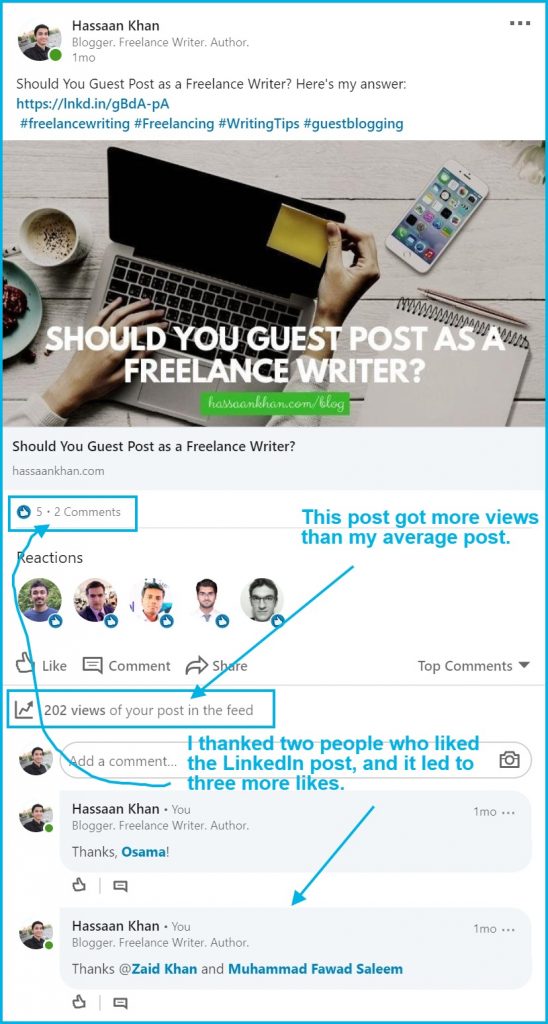
I only thanked two people who liked the post and three more followers liked my post. Once the engagement began, the reach automatically shoots to 200 views when I normally get 80 views on average. That’s the power of engaging with the community.
My argument on comments on LinkedIn got validated by an article on Sendible. They wrote this about LinkedIn content strategy:

A strong community brings in the engagement, attention, and reach to your content. Developing a strong community is crucial to your social media marketing campaign.
When we strive to skyrocket our LinkedIn reach through fresh content, repurposed content, and advertisements, we often overlook the resources available for free: it’s the engagement with the community.
You don’t need to be a social media marketing expert to pull this off. All you need is to be a little proactive with your questions, content sharing, answering queries, and highlighting people that can contribute to the community. Moreover, a group on social media doesn’t become a community unless you put in the work, stay consistent, and deliver value to the audience.
Also Read: Guide to Using LinkedIn for Business in 2024
Your Thoughts
I’ve shared five steps to alter or rejuvenate your Linked content strategy to skyrocket your LinkedIn reach.
One of the reasons why I wrote this piece is that I know LinkedIn has the potential to provide us with website traffic, prospective clients, leads, and attention.
Once you get started the right way, you’d notice that LinkedIn still has better organic reach than any other social media platform.
The five steps would enable you to design or reshape your digital marketing efforts using the power associated with the LinkedIn platform.
What else would you like to share with others about your experience on the LinkedIn platform?
Related Read: How We Gained 20K+ Organic Followers on LinkedIn via Content Marketing (A Case Study)
Recommended for you
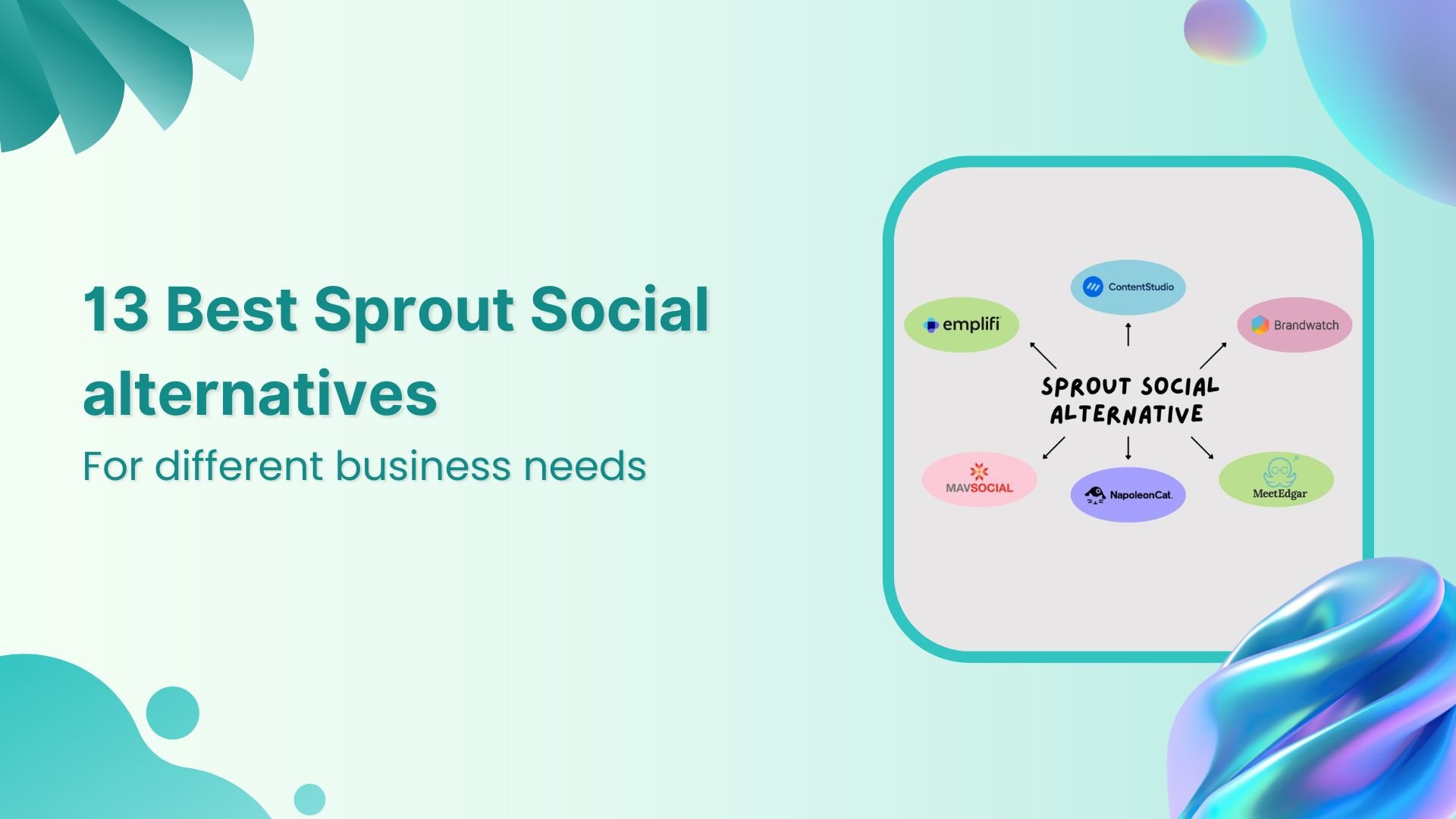
13 Best Sprout Social alternatives for effective social media management
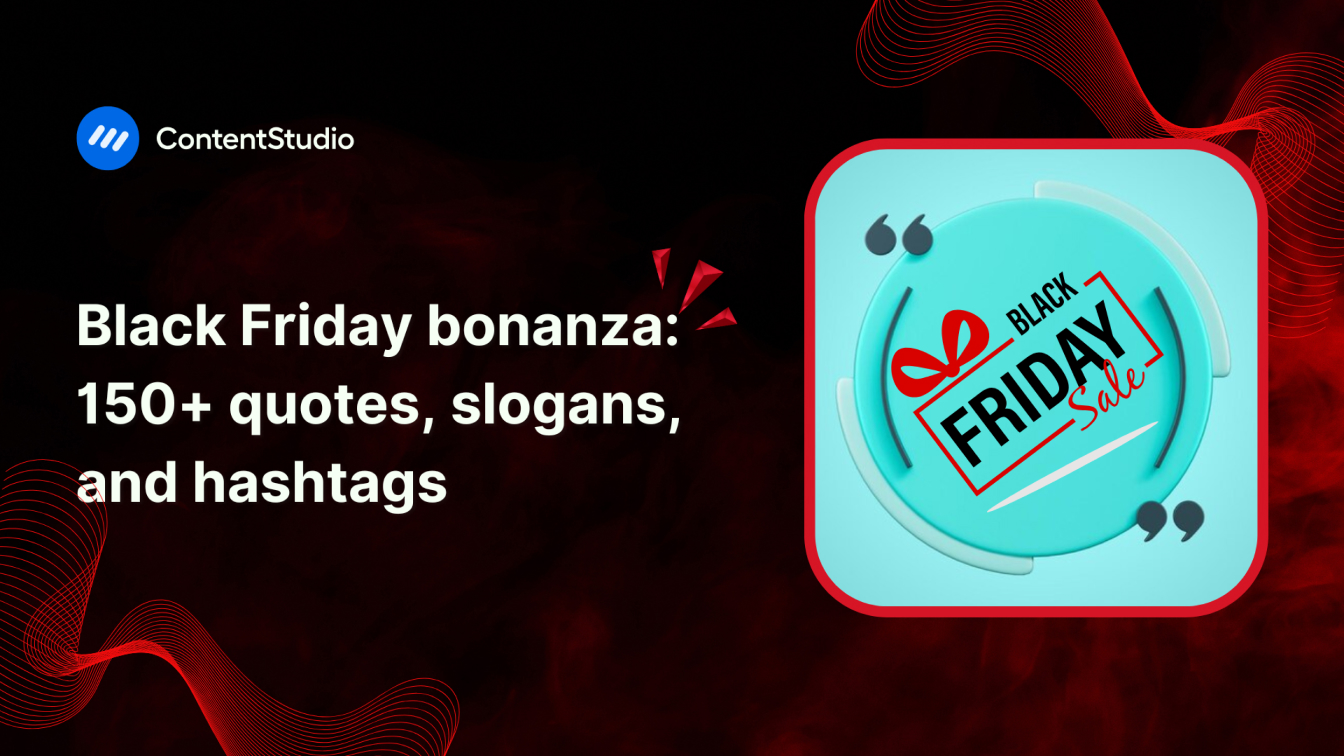
150+ Black Friday quotes, hashtags, and slogans to boost sales
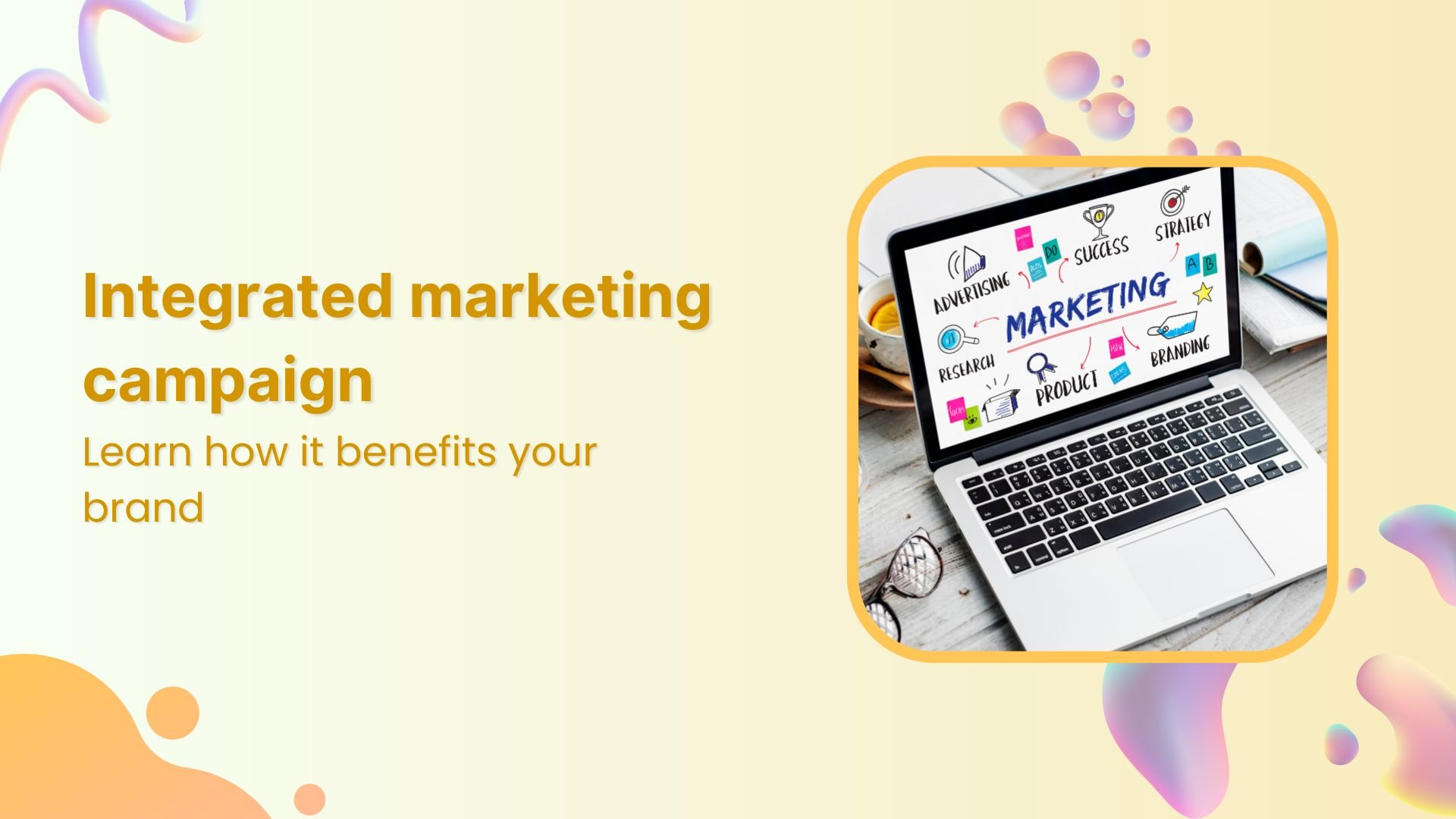
Why is an integrated marketing campaign beneficial for your brand?


Powerful social media management software
14-day free trial - No credit card required.
